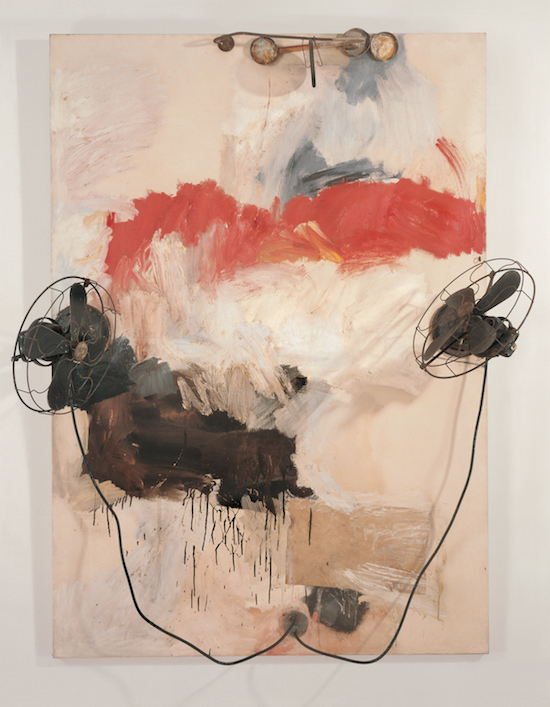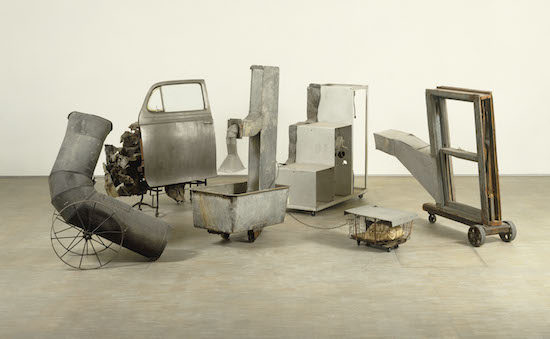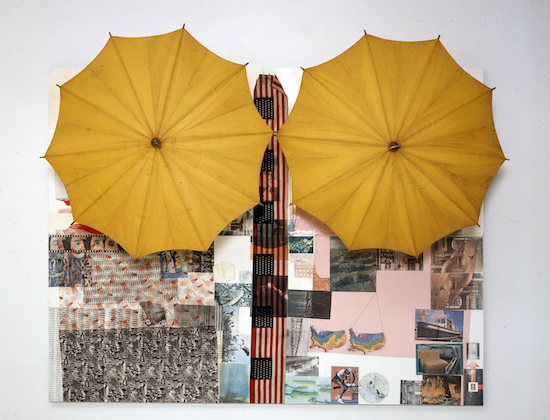Robert Rauschenberg, Untitled (Spread), 1983, Solvent transfer and acrylic on wood panel, with umbrellas, 188.6 x 245.7 x 88.9 cm © Robert Rauschenberg Foundation, New York
A famous story holds that when Robert Rauschenberg won the Grand Prize at the Venice Biennale in 1964 – the first American to do so – he promptly instructed his assistant to destroy all the silkscreens in his New York studio. He had no wish to repeat himself.
Clearly, a certain myth-making heroism is perpetuated by repeating that story and others like it, and it’s not to say he was always consistently great, or that new departures were always fantastically successful. But his energy and curiosity appear boundless, and that is what’s so great about Tate Modern’s thrilling, visually rich exhibition. You leave feeling energised yourself.
As a painter, as a sculptor (his hybrid Combines among his most recognisable work), as a performance artist, a dancer and choreographer, as a printer, as a maker of interactive stage designs, as a pioneering installation artist who worked with engineers and collaborated with others from a range of disciplines, Rauschenberg was always ready to explore, to leave behind the thing that had earned him most acclaim, and to venture forth with new projects, new collaborations, new ideas.
Part of Rauschenberg’s openness, this willingness to embrace risk, can perhaps be traced back to his art education at Black Mountain College in North Carolina in the late Forties, a school at the forefront of avant-garde thinking. Under the tutelage of former Bauhaus artists and tutors Josef and Anni Albers, he was encouraged to work with a range of materials, and to explore form and colour in relation both to each other and to what surrounded them. The wider college programme also insisted on an interdisciplinary approach for its students. It was a place to experiment. The friendships and romantic alliances he forged there, particularly with painter Cy Twombly, were to prove fruitful beyond measure. And it was there that he met composer John Cage and dancer and choreographer Merce Cunningham, two later collaborators whose impact and influence was direct and immediate.
Tate Modern’s retrospective takes a broadly chronological approach, beginning with small, gnarly gold leaf paintings, then on to one of his huge, smooth, reflective white paintings, which, in Cage’s formulation, were “airports for the lights, shadows and particles,” and “whatever fell on them” (they in turn inspired Cage’s 4’33, the silent ‘piano composition’ in which audiences were invited to become alert to ambient sounds, including their own sighs, coughs and breathing). And, with one example here, we find their opposite in the dense, opaque, resistant black paintings in latex paint.
And then we’re immersed in something altogether wilder, rougher, messier and visually richer: his red paintings. The wonderful multi-panel Charlene, 1954, is the last in that series, though he’s already thinking ahead to the Combines, those found objects and images that, splattered and smeared with paint, finally have a life beyond the flat canvas on a wall. Charlene’s busy, gestural brushstrokes are interrupted by a lightbulb, bits of lace and fabric, two light reflectors, a t-shirt, an open battered umbrella that rather looks like a painter’s colour wheel, and a vertical frieze of tiny, blurred replicas of famous artworks. It’s certainly very busy, a little chaotic, but in an incredibly harmonious, rhythmic kind of way. Rauschenberg had the most incredible eye for design, and from seeming fiery chaos something remarkably beautiful emerges.

Robert Rauschenberg, Pantomime, 1961, 213.4 x 152.4 x 50.8 cm, Oil, enamel, paper, fabric, wood, metal, rubber wheel, and electric fans on canvas, Private Collection © Robert Rauschenberg Foundation, New York
Of the fully-fledged Combines we have the famous paint-splattered Bed, 1955, and the paint-splodged goat, girdled by its rubber tyre in Monogram, 1955-59. Both might be said to be ‘about sex’, as critic Robert Hughes asserted of Monogram (though Rauschenberg denied any such thoughts – the artist, in fact, denied anything he made being ‘about’ anything, though as a neo-dada artist he would have recognised the role of the viewer in completing the art work). Those dribbles of thin white paint on actual bedding are nonetheless suggestive, and the goat, a symbol of lust encircled by a rubber orifice, well, naturally associations are made. Hughes, the swaggering, macho critic, was of course piquantly referring to Rauschenberg’s sexuality, at a time when being gay was something you couldn’t be particularly open about.
The Combines are wonderful, as are the canvases with their multiple objects playfully conversing. There’s wit, and seriousness and poetry in Rauschenberg, and as we get to the end of the Sixties and beyond a sonorous sense of tragedy plays out too. Images of the late JFK, civil war protests, the space race, now against an alarming backdrop of a cold war threatening to boil over very quickly, the bald eagle plastered with a Coca-Cola logo, an inverted Statue of Liberty, the late Bobby Kennedy, and Martin Luther King laid to rest. Rauschenberg uses the same motifs again and again in his screenprints and transfers, but unlike the curious detachment of Warhol’s repeated images, these jumbled and roughed-up compositions are almost plaintive.
Lesser known are Rauschenberg’s performances, and particularly his choreography with the Merce Cunningham Dance Company: we find him wheeling about on rollerskates, a billowing parachute attached to his back, spinning in hypnotic motion with dancer Carolyn Brown; or, in a more dada-esque performance, we find turtles with torches strapped to their shells and women dressed as brides, with clocks stuffed in their bosoms.
Or the magnificent Oracle, 1962-5, an ambitious assemblage realised with engineer Robert Klüver, with whom he later set up E.A.T (Experiments in Art and Technology) a non-profit organisation that brought together engineers and artists and with whom he made Mud Muse, a big bath of plopping wet bentonite clay.

Robert Rauschenberg, Oracle, 1962-1965, Museé National d’Art Moderne, Centre Georges Pompidou, Paris. Gift of Mr. and Mrs. Pierre Schlumberger, 1976 © Robert Rauschenberg Foundation, New York, Photo: Centre Pompidou, MNAM-CCI, Dist. RMN-Grand Palais / Droits réservés
Oracle is a kinetic sculpture that doesn’t actually do much moving, though everything is on wheels and casters. Here’s a ventilation duct standing in a metal tub on wheels, water flowing through the funnel. The tub is connected by a chain to a rusty metal basket on casters. To the right of this, a massive exhaust pipe is propped on an axel and two spindly pram wheels; to the left, a rickety window frame, on casters, has a ventilation duct bolted on to one side. A car door, stripped of paint, and a sheet of crushed metal, balance elegantly on a wheeled typewriter table. Completing the ensemble: metal steps on a wheelie trolley, and five hidden remote-controlled radios. Noises are emitted and a half-familiar tune faintly plays.
The piece completely rocks, and is clearly influenced by the compositions of John Cage. Look up Water Walk, performed by Cage on a cheesy American talk show in front of a giggling, baffled and slightly embarrassed audience in 1960 (it’s on YouTube) and you’ll find surprising similarities – the bath, the water, the radios.
This tantalising survey offers so much to take in in – Rauschenberg was prolific and was making things to the end, despite two strokes. When he moved to the island of Captiva, off Florida, in the early 70s, there’s a sense of too much restraint, too much tasteful minimal elegance. Then, like Matisse, he seems to spring to life again, when he returns to his screenprints. The screenprints breathe life and passion. They’re beautiful.
This first comprehensive, though by no means exhaustive, survey of Rauschenberg since his death in 2008 is an exhilarating ride. For sheer range and restless invention it seems he can hardly be beaten among artists of his own generation – the so-called neo-dadaists who took their lead from Marcel Duchamp and incorporated found objects in their work – or indeed any American artist before or since. However big a claim this may sound, he was protean in a way few artists ever manage to be.
Tate Modern’s Robert Rauschenberg exhibition lasts until 2 April 2017


